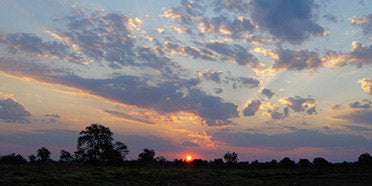- You are here:
- Home
- Countries & Parks
- Zambia Parks
- Blue Lagoon National Park
- Reviews
- Expert Reviews
Expert Reviews – Blue Lagoon NP

Ariadne is a renowned African wildlife photographer whose work is featured in many well-known guidebooks and magazines.
2 people found this review helpful.
A seasonal haven for the Kafue lechwe
We visited this park en route to Kafue and as a stopover it was well worth a little exploration. It protects a small portion of the Kafue Flats, the seasonal floodplain of the Kafue River. Although there are several accommodation buildings, they are all in different stages of disrepair and there is no water or electricity. Luckily, we were self-sufficient. Aside from a pair of barn owls and their chicks, which inhabited one of the buildings, we had the place to ourselves. The centerpiece of Blue Lagoon is a 5km causeway that runs into the floodplain. I don’t think you’ll see much on this short drive in the Dry season, but after the first rains, the flats transform into a wetland brimming with life. We were lucky as early rainfall had tinged the scenery green, which attracted what we had come for. We saw several big herds of Kafue lechwe, a semiaquatic antelope confined to the Kafue Flats. The birdlife was prolific too. At the end of the causeway is a turning point and a watchtower. With nowhere else to go, we sat back and waited for the sunset. And, as the wetland was glowing in the last rays of sunshine, we knew we had made the right call visiting this neglected haven for the endangered Kafue lechwe.

Emma is an award-winning travel writer for Rough Guides, National Geographic Traveller, Travel Africa magazine and The Independent.
2 people found this review helpful.
Bird-rich park, close to Zambia’s capital
Blue Lagoon National Park is in many ways the poor relation of its far larger neighbour Kafue, to the west, and, Lochinvar, which lies to the south, on the opposite side of the Kafue River. In my opinion, the main reason to consider coming to this flat, marshy expanse of bush rather than Kafue would be to take advantage of its proximity to Lusaka, which is only 120km away by road.
If you do make the trip, you could be rewarded with some excellent birdwatching, especially in the southern section. The park doesn’t reach as far south as the Kafue River, but it includes grasslands which flood when the river is high and harbour many water-loving bird species, along with large herds of Kafue lechwe. In the northern half, where the terrain is drier, animals are rather scarce.

Philip is an acclaimed travel writer and author of many guidebooks, including the Bradt guides to Uganda, Tanzania, Kenya and South Africa.
1 person found this review helpful.
A neglected bird-watcher’s paradise
It's difficult to imagine anybody other than a bird-watcher getting much out of Blue Lagoon National Park. But if you do enjoy birds, and you’ll be driving between Lusaka and Kafue National Park, it's worth making the diversion to this small and rather neglected park, which protects the northern part of the Kafue Flats, a vast, marshy wetland fed by the Kafue River.
The focal point of Blue Lagoon is a motorable 5km causeway that leads through the floodplain to a stilted viewing platform. From the causeway, we saw large numbers of aquatic birds, including spur-winged goose, rufous-bellied heron, black egret, saddle-billed stork and coppery-tailed coucal. Highlights included a lesser jacana with chicks treading across the floating vegetation, and a family of very screechy barn owls that evidently nest in the reception building next to the campsite.
From the viewing platform at the end of the causeway, we enjoyed panoramic views over the swamp, and saw several hundred-strong herds of Kafue lechwe, a striking semi-aquatic antelope whose range is more or less confined to the Kafue Flats. Other than a troop of vervet monkeys that evidently lurks around the campsite, lechwes were the only large mammals we saw in Blue Lagoon.
We were fortunate to visit Blue Lagoon after the first rains, which meant the water was sufficiently high to enjoy good bird watching from parts of the causeway. By all accounts, there's a lot less to see in the Dry season, when the marsh often retreats beyond the end of the causeway. By contrast, the bird watching must be pretty incredible at the height of the rainy season.


 Zambia Parks
Zambia Parks